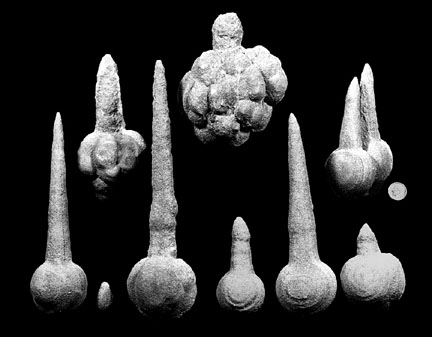EXCERPTED FROM: Oddities of
the Mineral World Van Nostrand Reinhold Company 1976. All rights reserved.
Sand Spikes: Found at the foot of Mount Signal,
Imperial County, California.
6" to 8" long. These strange concretions, called sand spikes, came from a
now-depleted locality near the Mexican-American border close to Mt. Signal, Imperial
County, California. The provocative formations of different sizes were discovered in beds
of sand, and they all were found pointing to the west!! THE SAND SPIKES FROM MOUNT
SIGNAL by WILLIAM B. SANBORN No discussion of concretions would be complete if mention
were not made of a real puzzler, a truly unique type of concretion that apparently remains
unexplained—sand spikes. The original locality is believed to have been discovered by
Mr. H. W. Pierce of Laguna Beach, who amassed a fabulous collection of the fascinating
formations and used them as trade items to assemble a very fine mineral collection. Mr.
Pierce also made generous donations of these amazing formations to museums throughout the
world. A few years ago my wife and I were visiting the superb mineral collection displayed
at the museum of natural history museum in Lyon, France and were delighted to see a case
devoted to sand spikes, courtesy of Mr. Pierce! Briefly, the locality consisted of a
series of low, sandy hillocks and banks near the Mexican-American border close to Mt.
Signal, Imperial County, California. When they were first discovered, many of these unique
concretions were weathering out on the surface of the ground. It became apparent,
however, that there actually were beds of these strange concretions 3 feet to 8 feet
underground! The following may be almost too much to believe, but, having collected at the
locality before it was decimated, I can assure you it is quite accurate. These concretions
consist of a ball-like end coupled with a tapering spike-like formation. In uncovering a
bed of spikes over 95 percent of the formations were found pointing west. Spikes of
similar types or formats seemingly occurred in the same bed or within lens-like
concentrations of the sand-spike formations. They range in size from over 11/2" to
over 13" in length and occur in a wide variety of shapes—perfectly round with
stubby or long, tapering spikes or knobby with rough spikes. The spikes were usually quite
damp and broke easily when uncovered, so they were dried in the sun before being handled.
They are composed of absolutely nothing but the identical sand forming the soft little
hillocks and banks in which they occur—solid sandstone with no fossil material
inside. The mineral cementing the grains together is apparently calcite. What are they? No
one really knows—other than they obviously fall under the heading of concretions by
virtue of their method of occurrence and basic mineralogical composition. The long points,
westerly oriented, are the most provocative aspect of this truly unique locality. There is
no surrounding evidence in the area to indicate any realistic fossil origin. However there
have been some truly far-out suggestions offered. Some say that they are fossils of an
ancient type of bulbous seaweed that drifted heavy-end eastward on some ancient shoreline.
Others have suggested that the have somehow been affected by an unknown magnetic force
that oriented their westerly growth. It has also been suggested that they are some type of
fulgurites, which is positively incorrect, and not by any stretch of the imagination are
they prehistoric man-made artifacts. In any event, it is always interesting to note that
there are, indeed, geological formations that still remain surrounded by an aura of
mystery. Incidentally, this locality has been totally exhausted by pick, shovel, and most
unfortunately, bulldozer. The latter technique was very unsuccessful, essentially managing
only to crush many hundreds of fine specimens.
|
